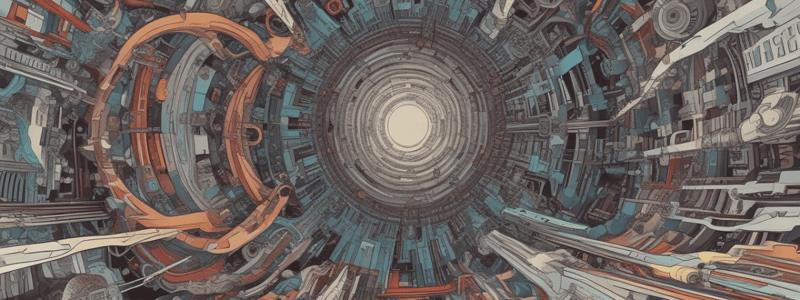Podcast
Questions and Answers
What is the defining characteristic of a (first-order) Markov chain?
What is the defining characteristic of a (first-order) Markov chain?
The next state only depends on the current state.
How can higher-order Markov chains be reduced to first-order?
How can higher-order Markov chains be reduced to first-order?
By the cross product.
Give an example to illustrate the Markov property.
Give an example to illustrate the Markov property.
The weather tomorrow depends on the current weather, not on last year’s weather.
How can Markov chains be used for text generation?
How can Markov chains be used for text generation?
What method is used to estimate transition probabilities in text generation with Markov chains?
What method is used to estimate transition probabilities in text generation with Markov chains?
What is an application of Hidden Markov Models mentioned in the text?
What is an application of Hidden Markov Models mentioned in the text?
What is a typical task in natural language processing that involves Hidden Markov Models?
What is a typical task in natural language processing that involves Hidden Markov Models?
In a Hidden Markov Model, what do the transition matrix and observation probability matrix represent?
In a Hidden Markov Model, what do the transition matrix and observation probability matrix represent?
What are the three main problems to solve with Hidden Markov Models?
What are the three main problems to solve with Hidden Markov Models?
What does the Evaluation Problem in Hidden Markov Models involve?
What does the Evaluation Problem in Hidden Markov Models involve?
What is the Decoding Problem in Hidden Markov Models?
What is the Decoding Problem in Hidden Markov Models?
What is the Learning Problem in the context of Hidden Markov Models?
What is the Learning Problem in the context of Hidden Markov Models?
Flashcards are hidden until you start studying
Study Notes
Markov Chains
- A first-order Markov chain is characterized by the memoryless property, where the next state depends only on the current state, not on the previous states.
- Higher-order Markov chains can be reduced to first-order chains by creating a composite state that encapsulates the history of the prior states.
Example of Markov Property
- An example illustrating the Markov property is the weather: if it is sunny today, the prediction for tomorrow's weather only relies on today's weather, regardless of the past week's weather patterns.
Markov Chains in Text Generation
- Markov chains can generate text by modeling the probability of word sequences, using the current word to predict the likelihood of the next word.
- Transition probabilities in text generation are estimated using frequency counts of word occurrences in a training corpus.
Hidden Markov Models (HMM)
- Hidden Markov Models are applied in various fields, such as speech recognition and bioinformatics for sequence analysis.
- A typical task in natural language processing involving HMMs is part-of-speech tagging.
Components of Hidden Markov Models
- The transition matrix in HMMs represents the probabilities of moving from one hidden state to another.
- The observation probability matrix indicates the likelihood of observing a particular output given a hidden state.
Problems in Hidden Markov Models
- The three main problems to be addressed with HMMs are:
- Evaluation Problem: Calculating the probability of an observed sequence given the model.
- Decoding Problem: Determining the most likely sequence of hidden states that produced the observed outputs.
- Learning Problem: Updating the model parameters to maximize the likelihood of the observed data.
Evaluation Problem
- The Evaluation Problem in HMMs involves computing the likelihood of a specific observation sequence based on the model parameters.
Decoding Problem
- The Decoding Problem seeks to find the best path (sequence of hidden states) that best explains the observed sequence of events.
Learning Problem
- The Learning Problem focuses on adjusting the HMM parameters, such as the transition and observation probabilities, to fit the model to the observed data effectively.
Studying That Suits You
Use AI to generate personalized quizzes and flashcards to suit your learning preferences.




